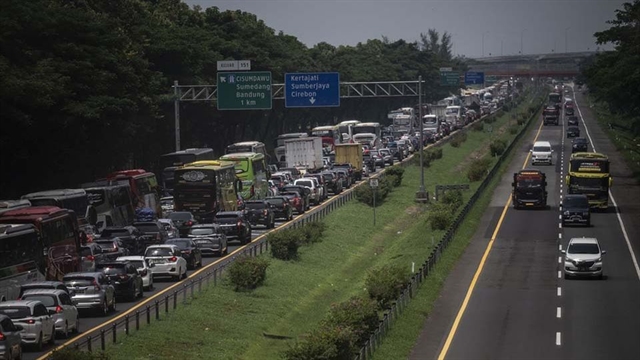 World
World


|
| Traffic congestion is observed at Kilometer 150 of the Cikopo-Palimanan toll road in Mekarjaya, West Java on April 5, 2024. Authorities forecast that the 2024 Idul Fitri mudik (exodus) season will peak between April 6 and 8. —THE JAKARTA POST/ANN |
JAKARTA — The nearly 200 million Indonesians expected to make the journey home for the Idul Fitri holiday face a heightened risk of extreme weather in their travels, authorities warned on Sunday, as the nation’s busy land and sea transportation routes accommodate what is expected to be a record-breaking mudik (exodus) season.
Outgoing Idul Fitri travel was expected to have peaked over the weekend amid an especially severe wet season that has seen flash flooding, landslides and other severe natural disasters.
The Meteorology, Climatology and Geophysics Agency (BMKG) asked mudik travelers on Sunday to be vigilant for possible instances of extreme weather, such as thunderstorms across Central Java, a key corridor for Idul Fitri travel.
“Areas in Central Java that could potentially be hit by extreme weather on Monday include Cilacap, Boyolali, Pemalang and the surrounding regencies,” said Teguh Wardoyo, head of the BMKG’s technical team in Cilacap on Sunday, as quoted by Antara.
The heightened potential for extreme weather was a symptom of the pancaroba season, Teguh said, the transition from the wet to the dry season.
Flash floods and landslides have hit regions across Indonesia throughout the rainy season since the start of the year. The season is persisting in some parts of the country.
With the Idul Fitri holiday slated to fall on either Tuesday or Wednesday, depending on the sighting of the moon, the BMKG has warned mudik travelers to be wary of coastal flooding.
The agency expects Central Java’s northern coast to be at a heightened risk of coastal flooding from April 2 to 7 and predicts that Banten’s coast, stretching from Pandeglang to Lebak regency, could see such flooding from April 9 to 14.
The BMKG also flagged the provinces of North Sumatra, Lampung, East Nusa Tenggara, Southeast Sulawesi and Maluku as being at an increased risk of flooding from April 6 to 14.
Inundated roads
Several floods affected mudik travel over the weekend, including on Jl. Kaligawa in Semarang, Central Java, on Saturday, after nonstop heavy rain in the area since Friday.
The floodwaters were up to 30 centimeters deep and caused severe congestion on Jl. Kaligawa, one of the main roads along the northern coast of Java and a constituent part of the Pantura highway, which is typically packed with mudik travelers all the way to regencies such as Demak and Rembang in Central Java.
Semarang Police traffic corps head Adj. Sr. Comr. Yunaldi said the local police squad had optimised the available water pumps to reduce the flooding. They were also diverting motorists to an alternate route leading onward to Demak.
Meanwhile, heavy rain around Mount Marapi in West Sumatra caused volcanic mudflows to hit parts of Tanah Datar regency on Friday.
The volcanic matter covered a segment of the national toll road connecting Padang Panjang and Bukittinggi, cutting off traffic in both directions. The National Disaster Mitigation Agency (BNPB) said on Sunday that the local disaster mitigation agency was still trying to clear the route of the remaining volcanic matter.
Marapi is the most active volcano in Sumatra and is one of many active volcanoes dotting the archipelago.
Heavy rains have also triggered landslides along highways, including one that caused a stretch of the Bogor-Ciawi-Sukabumi (Bocimi) to collapse on Wednesday night, injuring two people in a car.
Authorities expected temporary repairs to the section of road to be finished by Monday, before a more permanent recovery effort was to take place over the next two to three months.
Peak traffic
National Police traffic corps chief Inspector General Aan Suhanan said on Friday that this year’s mudik was expected to peak over the weekend.
With over 193 million Indonesians expected to hit the road, this year’s mudik season is likely to be the country’s largest ever.
State-owned toll road operator PT Jasa Marga said over 807,000 vehicles had left Greater Jakarta from Wednesday to Saturday, nearly a 13 percent year-on-year (yoy) increase, or about 714,000 more vehicles than last year.
For the Trans-Java toll road, Aan of the National Police said the peak of mudik travel could take place on Saturday night, with an estimated 178,000 cars hitting the road.
The traffic corps chief said the force was monitoring toll roads, arterial roads and holiday destinations.
“Overall, the second day of the holiday operation went smoothly,” Aan said in a statement on Saturday.
However, parts of the Tangerang-Merak toll road in Cilegon, Banten, experienced severe congestion in the direction of Merak port. Aerial footage taken by media outlets showed snaking traffic for kilometres on end. Motorists reportedly had to wait some 10 hours to get off the highway.
Coordinating Human Development and Culture Minister Muhadjir Effendy said this was because of a 65 percent increase in passengers going to Merak port compared to last year. In response, authorities permitted only drop-off service at the port and directed personal vehicles to another port.
Banyumas police chief Sr. Comr. Edy Suranta Sitepu said authorities had also prepared heavy-duty vehicles along the route to Banyumas in case of flooding, landslides or fallen trees.
“We are trying to ensure that travellers on the southern route can pass safely and comfortably,” he said on Sunday, as quoted by Antara. — THE JAKARTA POST/ANN




